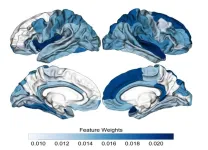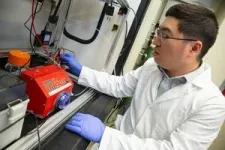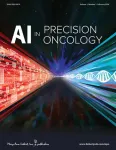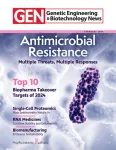(Press-News.org) The onset of psychosis can be predicted before it occurs, using a machine-learning tool which can classify MRI brain scans into those who are healthy and those at risk of a psychotic episode. An international consortium including researchers from the University of Tokyo, used the classifier to compare scans from over 2,000 people from 21 global locations. About half of the participants had been identified as being clinically at high risk of developing psychosis. Using training data, the classifier was 85% accurate at differentiating between people who were not at risk and those who later experienced overt psychotic symptoms. Using new data, it was 73% accurate. This tool could be helpful in future clinical settings, as while most people who experience psychosis make a full recovery, earlier intervention typically leads to better outcomes with less negative impact on people’s lives.
Anyone might experience a psychotic episode, which commonly involves delusions, hallucinations or disorganized thinking. There is no single cause, but it can be triggered by illness or injury, trauma, drug or alcohol use, medication, or a genetic predisposition. Although it can be scary or unsettling, psychosis is treatable and most people recover. As the most common age for a first episode is during adolescence or early adulthood, when the brain and body are undergoing a lot of change, it can be difficult to identify young people in need of help.
“At most only 30% of clinical high-risk individuals later have overt psychotic symptoms, while the remaining 70% do not,” explained Associate Professor Shinsuke Koike from the Graduate School of Arts and Sciences at the University of Tokyo. “Therefore, clinicians need help to identify those who will go on to have psychotic symptoms using not only subclinical signs, such as changes in thinking, behavior and emotions, but also some biological markers.”
The consortium of researchers have worked together to create a machine-learning tool which uses brain MRI scans to identify people at risk of psychosis before it starts. Previous studies using brain MRI have suggested that structural differences occur in the brain after the onset of psychosis. However, this is reportedly the first time that differences in the brains of those who are at very high risk but have not yet experienced psychosis have been identified.
The team from 21 different institutions in 15 different countries gathered a large and diverse group of adolescent and young adult participants. According to Koike, MRI research into psychotic disorders can be challenging because variations in brain development and in MRI machines make it difficult to get very accurate, comparable results. Also, with young people, it can be difficult to differentiate between changes that are taking place because of typical development and those due to mental illness.
“Different MRI models have different parameters which also influence the results,” explained Koike. “Just like with cameras, varied instruments and shooting specifications create different images of the same scene, in this case the participant’s brain. However, we were able to correct for these differences and create a classifier which is well tuned to predicting psychosis onset.”
The participants were divided into three groups of people at clinical high risk: those who later developed psychosis; those who didn’t develop psychosis; and people with uncertain follow-up status (1,165 people in total for all three groups), and a fourth group of healthy controls for comparison (1,029 people). Using the scans, the researchers trained a machine-learning algorithm to identify patterns in the brain anatomy of the participants. From these four groups, the researchers used the algorithm to classify participants into two main groups of interest: healthy controls and those at high risk who later developed overt psychotic symptoms.
In training, the tool was 85% accurate at classifying the results, while in the final test using new data it was 73% accurate at predicting which participants were at high risk of psychosis onset. Based on the results, the team considers that providing brain MRI scans for people identified as being at clinically high risk may be helpful for predicting future psychosis onset.
“We still have to test whether the classifier will work well for new sets of data. Since some of the software we used is best for a fixed data set, we need to build a classifier that can robustly classify MRIs from new sites and machines, a challenge which a national brain science project in Japan, called Brain/MINDS Beyond, is now taking on,” said Koike. “If we can do this successfully, we can create more robust classifiers for new data sets, which can then be applied to real-life and routine clinical settings.”
####
Paper Title:
Yinghan Zhu, Norihide Maikusa, Joaquim Radua, Philipp G. Sämann, Paolo Fusar-Poli, Ingrid Agartz, Ole A. Andreassen, Peter Bachman, Inmaculada Baeza, Xiaogang Chen, Sunah Choi, Cheryl M. Corcoran, Bjørn H. Ebdrup, Adriana Fortea, Ranjini RG. Garani, Birte Yding Glenthøj, Louise Birkedal Glenthøj, Shalaila S. Haas, Holly K. Hamilton, Rebecca A. Hayes, Ying He, Karsten Heekeren, Kiyoto Kasai, Naoyuki Katagiri, Minah Kim, Tina D. Kristensen, Jun Soo Kwon, Stephen M. Lawrie, Irina Lebedeva, Jimmy Lee, Rachel L. Loewy, Daniel H. Mathalon, Philip McGuire, Romina Mizrahi, Masafumi Mizuno, Paul Møller, Takahiro Nemoto, Dorte Nordholm, Maria A. Omelchenko, Jayachandra M. Raghava, Jan I. Røssberg, Wulf Rössler, Dean F. Salisbury, Daiki Sasabayashi, Lukasz Smigielski, Gisela Sugranyes, Tsutomu Takahashi, Christian K. Tamnes, Jinsong Tang, Anastasia Theodoridou, Alexander S. Tomyshev, Peter J. Uhlhaas, Tor G. Værnes, Therese AMJ. van Amelsvoort, James A. Waltz, Lars T. Westlye, Juan H. Zhou, Paul M. Thompson, Dennis Hernaus, Maria Jalbrzikowski, Shinsuke Koike, and the ENIGMA Clinical High Risk for Psychosis Working Group. Using Brain Structural Neuroimaging Measures to Predict Psychosis Onset for Individuals at Clinical High-Risk. Molecular Psychiatry. DOI: 10.1038/s41380-024-02426-7
Funding:
This research was supported in part by AMED (Grant Number JP18dm0307001, JP18dm0307004, and JP19dm0207069), JST Moonshot R&D (JPMJMS2021), JSPS KAKENHI (JP23H03877 and JP21H02851), Takeda Science Foundation and SENSHIN Medical Research Foundation. This study was also supported by the International Research Center for Neurointelligence (WPI-IRCN), the University of Tokyo.
Conflicts of Interest:
Author OAO conducted a consultant to cortechs.ai, received speaker’s honorarium from Lundbeck, Janssen, Sunovion.
Author BYG has been the leader of a Lundbeck Foundation Centre of Excellence for Clinical Intervention and Neuropsychiatric Schizophrenia Research (CINS) (January 2009 – December 2021), which was partially financed by an independent grant from the Lundbeck Foundation based on international review and partially financed by the Mental Health Services in the Capital Region of Denmark, the University of Copenhagen, and other foundations. All grants are the property of the Mental Health Services in the Capital Region of Denmark and administrated by them.
Other authors have no conflict of interest to declare that are relevant to the content of this article.
Useful Links
Graduate School of Arts and Sciences: https://www.c.u-tokyo.ac.jp/eng_site/
Center for Evolutionary Cognitive Sciences: https://ecs.c.u-tokyo.ac.jp/en/home/home.html
Koike Lab: https://klab.c.u-tokyo.ac.jp/en/
Research Contact:
Associate Professor Shinsuke Koike, M.D., Ph.D.
Center for Evolutionary Cognitive Sciences,
Graduate School of Arts and Sciences, The University of Tokyo
3-8-1 Komaba, Meguro-ku, Tokyo 153-8902, Japan
E-mail: skoike-tky@umin.ac.jp
Telephone: +81-3-5454-4327; Fax: +81-3-5454-4327
Press contact:
Mrs. Nicola Burghall
Public Relations Group, The University of Tokyo,
7-3-1 Hongo, Bunkyo-ku, Tokyo 113-8654, Japan
press-releases.adm@gs.mail.u-tokyo.ac.jp
About the University of Tokyo
The University of Tokyo is Japan's leading university and one of the world's top research universities. The vast research output of some 6,000 researchers is published in the world's top journals across the arts and sciences. Our vibrant student body of around 15,000 undergraduate and 15,000 graduate students includes over 4,000 international students. Find out more at www.u-tokyo.ac.jp/en/ or follow us on X (formally Twitter) at @UTokyo_News_en.
END
Predicting psychosis before it occurs
Brain images from thousands of people worldwide have been used to create a machine learning-based classifier that could aid early diagnosis
2024-02-09
ELSE PRESS RELEASES FROM THIS DATE:
New research shows students' knowledge and perceptions of active learning declined during pandemic-era teaching
2024-02-09
Students’ knowledge and perceptions of active learning declined significantly during COVID-induced remote teaching and have not recovered to pre-pandemic levels, according to new research from Chapman University Assistant Professor Jeremy Hsu.
Hsu says the benefits of active learning – exercises like group projects, problem-solving and class discussions – are well documented, but he emphasizes that students’ understanding and perceptions of the practice can affect their level of engagement and investment. If students have limited exposure or are hesitant to participate in active learning practices, resistance could ...
Evaluating the performance of AI-based large language models in radiation oncology
2024-02-09
A new study evaluates an artificial intelligence (AI)-based algorithm for autocontouring prior to radiotherapy in head and neck cancer. Manual contouring to pinpoint the area of treatment requires significant time, and an AI algorithm to enable autocontouring has been introduced. The study is published in the peer-reviewed journal AI in Precision Oncology. Click here to read the article now.
Nikhil Thaker, from Capital Health and Bayta Systems, and coauthors, evaluated the performance of various LLMs, including OpenAI’s GPT-3.5-turbo, GPT-4, GPT-4-turbo, ...
Sandia awarded for outstanding work in technology transfer
2024-02-09
ALBUQUERQUE, N.M. — One of Sandia National Laboratories’ core missions is to help the world through innovation.
However, transferring some of that innovation from the Labs to industry isn’t always an easy process.
Through hard work and ingenuity, some Sandia employees are excelling at moving technology to market, a feat that is now being honored by the Federal Laboratory Consortium. The consortium, composed of more than 300 members nationwide, provides a forum to develop strategies and opportunities for linking laboratory technologies and expertise in the marketplace.
Regional Technology Transfer Award: Disinfectant ...
Evaluating AI-based nodal contouring in head and neck cancer
2024-02-09
A new study evaluates an artificial intelligence (AI)-based algorithm for autocontouring prior to radiotherapy in head and neck cancer. Manual contouring to pinpoint the area of treatment requires significant time, and an AI algorithm to enable autocontouring has been introduced. The study is published in the peer-reviewed journal AI in Precision Oncology. Click here to read the article now.
Sushil Beriwal, from Allegheny Health Network, and Varian, and coauthors, analyzed 108 patients ...
The Lancet: Black women in the USA were murdered six times more often than White women between 1999 and 2020, state-level analysis indicates
2024-02-09
Analysis of racial disparities in US homicide rates indicates Black women were on average six times more likely to die by homicide than White women between 1999 and 2020.
Homicide rates among Black women were significantly higher than for White women in all 30 states analysed, with some evidence suggesting the biggest differences are in states with the highest racial inequities.
The greatest disparity in homicide rates was in Wisconsin in 2019-2020, when Black women were 20 times more likely to be ...
Study shows clinical benefit of new way of treating advanced ER+ breast cancer
2024-02-09
A research paper published today (8 February 2024) in The Lancet Oncology demonstrates that the drug enobosarm, a selective androgen receptor modulator which stimulates the male sex hormone receptor has anti-tumour effects in oestrogen receptor positive breast cancer patients.
Lead author Professor Carlo Palmieri from the University of Liverpool and The Clatterbridge Cancer Centre NHS Foundation Trust, said: “These results are very encouraging – we have shown that in advanced/metastatic breast cancer ...
Repeat testing for pre-eclampsia does not lead to better outcomes for pregnant women, but a single test is still beneficial
2024-02-09
A single test to speed up diagnosis of a serious disease in pregnant women does not need to be repeated, new research has found.
Results from the PARROT-2 trial, published today in the Lancet by researchers from King’s College London and funded by Jon Moulton Charitable Trust, Tommy’s Charity and the National Institute for Health and Care Research, has ruled out the need for routine repeat placental growth factor-based testing (PIGF) for all women with suspected pre-eclampsia.
PARROT-2 is a large, multi-centre UK trial in 1,252 women ...
Industrial pollution leaves its mark in Mediterranean corals
2024-02-09
UCL Press Release
Under embargo until Friday 9 February, 00:01 UK time
Industrial pollution leaves its mark in Mediterranean corals
For the first time, pollutants from burning fossil fuels have been found embedded in corals, offering scientists a potential new tool to track the history of pollution, finds a new study led by UCL researchers.
The study, published in the journal Science of the Total Environment, identified carbon particles emitted by burning fossil fuels embedded in the corals of Illa Grossa Bay, off the Columbretes Islands in the Mediterranean Sea. Finding this type of pollution – known as fly-ash or spheroidal carbonaceous particles (SCPs) ...
Urgent call for antitrust measures to safeguard innovation in spatial biology
2024-02-09
Recent breakthroughs in spatial biology technology have transformed biomedical research; however, legal disputes are preventing small, innovative companies from advancing new technologies and ideas. Ongoing litigation poses a threat to the progress of even the most promising scientific technologies and the potential discoveries they could enable, according to the authors of the exclusive article titled “Sounding an Alarm Over Spatial Biology,” in Genetic Engineering and Biotechnology News (GEN). Click here to read the article ...
Pre-diabetes gets its due: New $1.2 million award aimed at early intervention and treatment
2024-02-09
SAN ANTONIO, Feb. 8, 2024 – More than one out of three people have pre-diabetes, characterized by abnormal blood sugar levels not yet in the diabetes range – and yet associated with significant increases in eye, kidney and neuropathic diseases, and risk of cardiovascular death.
Moreover, the number of people with the condition is expected to double by 2030, with prevalence substantially higher in minority populations, including Hispanics. Both pre-diabetes and diabetes are considered global epidemics.
As pre-diabetes largely is underdiagnosed and undertreated, ...
LAST 30 PRESS RELEASES:
Norbert Holtkamp appointed director of Fermi National Accelerator Laboratory
New agentic AI platform accelerates advanced optics design
Biologists discover neurons use physical signals — not electricity — to stabilize communication
Researchers discover that a hormone can access the brain by hitchhiking
University of Oklahoma researcher awarded funding to pursue AI-powered material design
Exploring how the visual system recovers following injury
Support for parents with infants at pediatric check-ups leads to better reading and math skills in elementary school
Kids’ behavioral health is a growing share of family health costs
Day & night: Cancer disrupts the brain’s natural rhythm
COVID-19 vaccination significantly reduces risk to pregnant women and baby
The role of vaccination in maternal and perinatal outcomes associated with COVID-19 in pregnancy
Mayo Clinic smartwatch system helps parents shorten and defuse children's severe tantrums early
Behavioral health spending spikes to 40% of all children’s health expenditures, nearly doubling in a decade
Digital cognitive behavioral treatment for generalized anxiety disorder
Expenditures for pediatric behavioral health care over time and estimated family financial burden
Air conditioning in nursing homes and mortality during extreme heat
The Alps to lose a record number of glaciers in the next decade
What makes a good proton conductor?
New science reporting guide published for journalists in Bulgaria
New international study reveals major survival gaps among children with cancer
New science reporting guide published for journalists in Turkey
Scientists develop a smarter mRNA therapy that knows which cells to target
Neuroanatomy-informed brain–machine hybrid intelligence for robust acoustic target detection
Eight SwRI hydrogen projects funded by ENERGYWERX
The Lundquist Institute and its start-up company Vitalex Biosciences Announces Strategic Advancement of Second-Generation fungal Vaccine VXV-01 through Phase 1 Trials under $40 Million Competitive Con
Fine particles in pollution are associated with early signs of autoimmune disease
Review article | Towards a Global Ground-Based Earth Observatory (GGBEO): Leveraging existing systems and networks
Penn and UMich create world’s smallest programmable, autonomous robots
Cleveland researchers launch first major study to address ‘hidden performance killer’ in athletes
To connect across politics, try saying what you oppose
[Press-News.org] Predicting psychosis before it occursBrain images from thousands of people worldwide have been used to create a machine learning-based classifier that could aid early diagnosis







